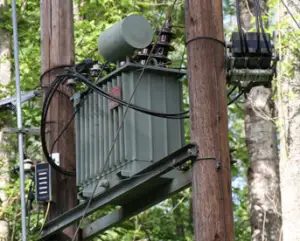A distribution transformer is one of the types of transformer. They are used only for distribution purposes. These transformers can be easily seen in your localities. The distribution transformers (generally pole mounted) are those installed in the location to provide utilization voltage at the consumer terminals. The secondary of a distribution transformer is connected directly to the consumer’s terminals. In this article, we will learn more about distribution transformer parts, their types, and ratings.
What is distribution transformer?
These are the step-down transformer (w.r.t. voltage) used in the distribution network end to provide utilization voltage at the consumer terminals. The following image shows a distribution transformer.

The size of a distribution transformer is small as compared to a power transformer. A distribution transformer may have tappings at the transformer secondary.
A distribution transformer can be a single-phase or three-phase type. In a three-phase distribution transformer primary winding connected in delta and secondary in star. A three-phase distribution transformer is used in the Delta-Star configuration.
A distribution transformer operated below the full or rated load. It operates 24 hours a day no matter whether a load is present or not. The load fluctuations are more in the distribution transformer as compared to the power transformer.
The primary of a distribution transformer is always connected to the supply. Hence the core losses occur continuously throughout the day. These losses are constant losses and hence independent of the variation of load. Hence a distribution transformer is designed with minimum core losses.
The copper losses depend upon the connected load. Since the load varies throughout the day. Hence copper losses also vary throughout the day. It is not a fixed loss.
A distribution transformer is designed with small leakage reactance. The flux density is lower in the distribution transformer as compared to the power transformer. A distribution transformer has very good voltage regulation. Generally, the maximum efficiency of a distribution transformer varies between 50% and 70%.
The performance of a distribution transformer is judged from all-day efficiency and not from general transformer efficiency.
Distribution transformer rating
Distribution transformers are used for lower voltage distribution networks as a means to end-user connectivity. They are generally rated less than 200 MVA and their secondary rating may be one of these, 11 kV, 6.6 kV, 3.3 kV, 440 V, 230 V.
Types of distribution transformer
The distribution transformer can be classified as
1. Based on Mounting location
- Pole-mounted distribution transformer
- Pad-mounted distribution transformer
- Underground vault-mounted distribution transformer
2. Based on the type of insulation used
- Liquid-immersed type distribution transformer
- Dry-type distribution transformer
3. Based on the number of phases
- Single-phase distribution transformer
- Three-phase distribution transformer
Parts of distribution transformer
The parts of the distribution transformer are given below.
- laminated core
- windings
- breather
- Buckholz relay
- transformer oil
- insulation
- explosion vent
- tap changer
- cooling tubes
- conservator tank
The function of each part is explained in this article – Different Parts of Transformer and their functions.
I hope this article clears your concepts regarding distribution transformer in detail. You can also read the difference between distribution transformer and power transformer.
